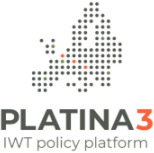Executive summary
This executive summary concisely presents the main findings and recommendations from the deliverable. It first briefly discusses the relevant policy background. This is followed by the main gaps and challenges that lie in the path of clean energy infrastructure to be realised. Finally, it briefly addresses what this means for policy makers.
Policy background
Following the EU Green Deal and Sustainable and Smart Mobility Strategy (SSMS), the inland waterway transport (IWT) sector needs to move towards zero-emission in 2050. A clean energy infrastructure is required to enable this transition. In general, there is a consensus on the need for a transition to cleaner IWT and hence the need for a clean energy infrastructure for IWT. However, there are differences in the details of the vision and approaches for the future clean energy infrastructure and the gaps and challenges that lie on the path. Especially at the level of European IWT countries, it will be crucial to develop and align national and regional strategies for the development of the clean energy infrastructure. The TEN-T corridor programs and European Coordinators of the corridors should coordinate and assist Member States in the creation of joint policy frameworks and strategies.
Need for clean energy infrastructure for IWT to be triggered by demand
At the moment, the greatest challenge for the clean energy infrastructure for IWT has an economic nature and concerns the currently minimal demand from vessel operators for clean energy. Demand and supply should develop in a balanced way. Policies and incentives (i.e. grants) should stimulate combined projects that will ensure a first critical mass of demand for clean energy, considering a corridor approach. This will help ensuring an initial consumption of clean energy which is large enough for suppliers of clean energy to invest in the required energy infrastructure. When the right market conditions are met, clean energy suppliers can move relatively easy given their financial capacity, as compared to small individual vessel owners, and invest in infrastructure once there is a prospect of a market.
Need for synergies and economies of scale
It should be considered though that IWT is seen as a small and fragmented market for energy suppliers, and hence the infrastructure would only support a limited number of forms of clean energy. Otherwise, the infrastructure becomes too costly with potentially a negative impact on factors such as price and availability of the supplied energy. This should be well thought out and synergies should be created wherever possible with other industries and transport modes for the supply of clean energy, e.g. with clean energy hubs.
Clean energy needs to be competitive compared to fossil fuels
The current status of bunkering fossil diesel is one of high availability on short notice, high service, flexibility and relatively low prices. It will, especially in its initial phase, be difficult for the alternative clean energy infrastructure to compete with. Laws and regulations should therefore be facilitative in terms of the realization and operation of the clean energy infrastructure for IWT. The right framework conditions should apply so that clean energy infrastructure operators can compete with the infrastructure for fossil fuels. The same line of reasoning applies for vessel operators sailing on clean energy. The right framework conditions should also be in place for the operators of the vessels, which naturally strengthens the realization of the clean energy infrastructure.
Important to address regulations and permits
There are also economic challenges with regulatory/legal causes, such as cumbersome permitting procedures and rules for the construction and operation of clean energy infrastructure, driving up costs for companies investing in the infrastructure. Experiences were gained with the construction and operation of the LNG bunkering station in Cologne and LNG truck-to-ship deliveries, lessons should be learned from this and rules and procedures should be eased where possible. Rules and procedures can be very different between countries and even at local level. However, for a clean energy provider, it would help if the rules and procedures were aligned. Overall, laws and regulations should be facilitative as much as possible for the development of the clean energy infrastructure. Learning from the LNG bunkering infrastructure for IWT is also possible in other areas. This especially concerns the operation of the bunkering infrastructure, i.e. with operating the bunkering station in Cologne, bunkering pontoons and the truck-to-ship supplies. Lessons can be learned from the technical difficulties in construction and initial operations, this could be very relevant for the future (liquid) H2 infrastructure.
How to use the existing bunkering infrastructure
On the technical front, the challenge is to utilize the existing bunker infrastructure to store and deliver clean energy to vessels. Existing bunkering stations and bunker boats are not necessarily technically suitable for this, depending on the energy carrier to be dealt with; there are also legal bottlenecks here due to safety rules and permits. I.e. existing bunker boats are not allowed to carry H2 stacks. It would help to map the details here to understand if and how the existing bunker infrastructure can be utilized for the storage and delivery of clean energy to inland vessels. This allows the use of an existing and proven infrastructure and avoids stranded assets.
On shore power supply to be uniform and scalable in capacity for charging batteries
For Onshore Power Supply (OPS) it is important to have the necessary electricity infrastructure in place. The grid should reach the quay side (in an effective manner), meet the demand (also from inland cruise vessels) and there should be a uniform concept for the operation of the shoreside power connections and a commonly accepted payment method. Looking to the future, it is also essential to set up OPS points in such a way that they can also be utilized for (rapid) charging of batteries on board used for propulsion of the vessel. However, it does appear that this is technically very complex and requires a lot of infrastructural modifications to make a regular OPS point ready to serve as a charging point to charge batteries on board of vessels used for the propulsion of the vessel.
Future of exchangeable energy storage concepts using existing container terminals
With containerized energy storage for e.g. batteries and hydrogen (and possibly also other forms of clean energy), there are technical challenges both on the vessel and ashore. Not all (existing) vessels will be suited to carry containers and large parts of the sector never visit container terminals. Furthermore, a lot of inland terminals are still operated by one crane only and may not be able to take on the additional handling of clean energy-containers. However, swapping locations could also be at shore-side locations along waterways and not necessarily at container terminals. The feasibility of this would need to be mapped.
Build up the new infrastructure step-by-step on corridor level
For suppliers of clean energy it will be technically challenging to provide (full) geographic coverage for their customers, since a large proportion of vessels operate on the spot market and will have varying sailing trajectories and may not be able to bunker and charge clean energy always on the same place. This will imply, especially in the deployment phase, a development of the clean energy infrastructure for specific cases and dedicated routes (e.g. container vessels, ferries, etc.) on limited parts of a corridor.
Mind shift needed in usage of new energy carriers
Clean forms of energy such as H2 are not the same as fossil diesel and require a significant mind shift in the supply and bunkering of the fuel as well as the operations of the vessel. The stakeholders who are going to be affected should become aware of this need for a mind shift in a timely manner.
Will there be sufficient supply of clean energy at competitive prices?
An overarching technical challenge is whether there will be enough supply of clean energy in all European IWT countries to meet the 55% GHG reduction targets by 2030. This is not yet entirely clear and is also going to depend on demand from other modes of transportation and industries. This should be monitored closely and it should be made clear what the prospects are for IWT in the various European countries and regions.
Work to do to develop a facilitating legal framework and procedures
On the legal front, there are many standalone challenges and gaps. In addition, technical and, to a lesser extent, economic challenges can also have a legal basis and/or could be solved by legal measures. Legal bottlenecks that suppliers of clean energy (will) encounter in practice are in the field of supplying/taking alternative clean energy on board of the vessel and the construction and operation of the clean energy infrastructure. This relates e.g. to port bye-laws and legislation at a higher level that need to include provisions for bunkering/charging/swapping clean energy, harmonised bunkering checklists and procedures that are lacking, complex permits and procedures for building the infrastructure and for bunkering alternative clean fuels through truck-to-ship at reserved quays. Complex permits and procedures can also form a bottleneck for supplying clean forms of energy at existing bunkering stations and for providing multiple forms of clean energy next to each other at the same location.
Gaps to be addressed by policy makers, mainly to develop the demand for clean energy
For policymakers, it is of great interest to adequately assess the identified gaps and challenges that lie on the path and take advantage of them for policies and incentives related to the clean energy infrastructure development for IWT. The biggest challenge is seen in developing the demand for clean energy carriers, meaning vessel owners/operators demanding clean energy because they can make a business case or to have a ‘licence to operate’.

